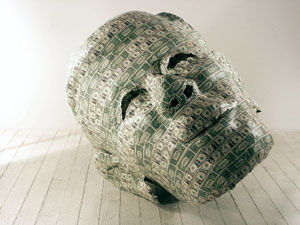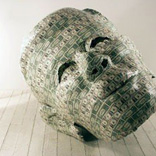Artist and writer Christopher French interviewed Helfenstein at his Menil office on February 5, 2004.
Josef Helfenstein came to Houston this January, becoming the fourth director in the 16-year history of The Menil Collection. Born in Lucerne, Switzerland, the 46-year old Helfenstein studied art history, German literature and history before receiving his PhD at the University of Bern. He served for five years as associate director of the Bern and as chief curator the museum’s prints and drawings department and Paul Klee Foundation. While there, he embarked on a 9-volume catalogue raisonné of the Swiss modernist painter’s art. In 2000 he came to the United States to serve as director of the Krannert Museum at the University of Illinois, Champaign-Urbana, a mid-sized university art gallery with a substantial permanent collection.
Artist and writer Christopher French interviewed Helfenstein at his Menil office on February 5, 2004.
Leaving the Krannert for the Menil Collection is a big change — what appealed to you about this job?
I didn’t come looking for a job; it came looking for me. I thought a long time and talked with many colleagues before taking the job. The Menil is, at least for me, the most beautiful museum in the world, with a special mission, history, and future. It is an incomparable institution. On the other hand it has a history as a teaching collection, and that of course is very similar to the mission of the Krannert.
I have only been here full-time a little more than two weeks, but in my first official visit last December I visited my colleagues at other institutions — the MFAH, the Blaffer, the CAM, and the Rice Art Gallery. It is a great thing to have colleagues. Houston is a sprawling city, and I am still getting used to it, but the transition from small town Champaign-Urbana to Houston has not been a shock. On my first weekend here I bought a bicycle and rode all over the district. That was great. For me a bicycle is the way to discover a city like Houston.
How would you describe your approach as director?
One has to be very careful in order to do the right thing for the future. And that means taking a little bit of time to really get to know the place — certainly no radical changes immediately. For me to know where I have to go it is very important to get to know the collection well, to get to know the people well. Then the projects will come. I don’t know how it will look in three years, but I know it will be different. I think the idea of the status quo forever is unrealistic.
The MFAH is Houston’s encyclopedia, with other institutions playing supporting roles as kunsthalles. Where does the Menil fit in?
For me the Menil is a combination of a museum of modern art and a “treasure house.” I say a museum of modern art because the Menil, like the Museum of Modern Art, really reflects the history of modernism in the original sense, where modern art appropriated all kinds of culture. MOMA did, especially in its first decades, many shows exploring these roots — popular culture but especially nonwestern and outsider art. On the other hand, the “treasure house” aspect is the privacy, intimacy and very idiosyncratic quality that the Menil has, and hopefully always will have.
I think rather than an encyclopedia, the Menil is more like an archipelago. If you look at the collection, you have isolated pieces, masterpieces, and large groups of work. I think it will continue in that direction. I hope the Menil will never become an encyclopedia, but will always combine works by contemporary and historical artists, artifacts as well as fine art objects. These are permeable boundaries, and this is one of the great energizing aspects of this job. I remember when I came here first, in 1989, two years after the Menil opened. I saw amazing dialogues between pieces with totally different backgrounds and origins.
I also see the Menil as much more than an importer of exhibitions. I see us as a laboratory, as a thinking institution. The specificity of the collection should lead us to generate projects rather than only take them. I would also love to work with other area institutions, as we did with the MFAH for the recent Rosenquist retrospective.
Your background is predominantly in scholarship — will you be able to continue organizing shows as director?
I will curate shows. I think the director of the Menil has to do intellectual work. But I have quite a bit of experience in terms of administration. In Berne I oversaw a large staff and a big collection, and I worked internationally with many institutions. I made my mistakes, and hopefully learned from them. My involvement with the Klee catalogue raisonné was both scholarly and hugely administrative. Organizing a catalogue raisonné is a huge burden — not only research, but because we had to raise all the money.
One show I will do is Klee and America. This show is scheduled for 2006, and it will trace the history of his work in the US, leading to a story of collecting in the US, involving very interesting people like Mies van der Rohe and Walter Arensberg, and Galka Scheyer as well as institutions like MoMA. Duncan Phillips also collected Klee in depth, and the show will go to the Phillips Collection and several other venues.
Another show represents two African-American artists in different ways than their work has been understood. William Edmondson was the first black artist to have a show at MOMA, in 1937. He was a carver, a sculptor. Both he and Bill Traylor have very similar biographies. They were elderly when they were discovered, celebrated for a short time, and then forgotten for three decades before being recently rediscovered. This show will originate at the Krannert and will travel to several venues before coming to the Menil.
Has the Menil reached critical mass, or do you see a future enlargement of the “campus” structure of multiple, related buildings as one of your goals?
This will be one of the big areas of discussion that we will have very soon. I think we will grow in some ways, because there are too many good ideas, there is too much passion, and too many really good artists who have a special affection for the Menil. So I think we might perhaps add to the existing structure. But this is really an open question, although I am dedicated to the concept of the Menil “campus.” What is so unique about the Menil is that it is far more than a museum, to the point where it has shaped the community environment and the city.
Public perceptions of the recent history of the Menil board are of division and meddling. How do you address the polarization between those who favor preserving the Menil’s past & those who would embrace the present?
Maybe I am just lucky, but I am convinced that this period of transition is really over. I have not had any sense of division so far, and I have looked very carefully. I believe the board is unified. I think the feeling is that a rather difficult period is over and we can move forward now. I think everybody agrees that this should be the next step. This is an extremely generous board, and the institutional finances are good — the foundation is in good shape.
Does the Menil have any special responsibility to the Houston art community — can the same special relationship that the Menil has had with national and international artists take place with area artists?
Artists are usually very critical of museums, which I think is good, and I have always learned a lot from them. Getting to know artists has always helped me to find my way. Even in Champaign-Urbana, where everyone told me there were no artists, it was not true, and the Krannert organized a show around this subject. We will try to do something very special with contemporary artists, in addition to building the collection — perhaps by inviting local artists and writers to give talks and to develop other programs. I think Houston artists will fit into the process.




